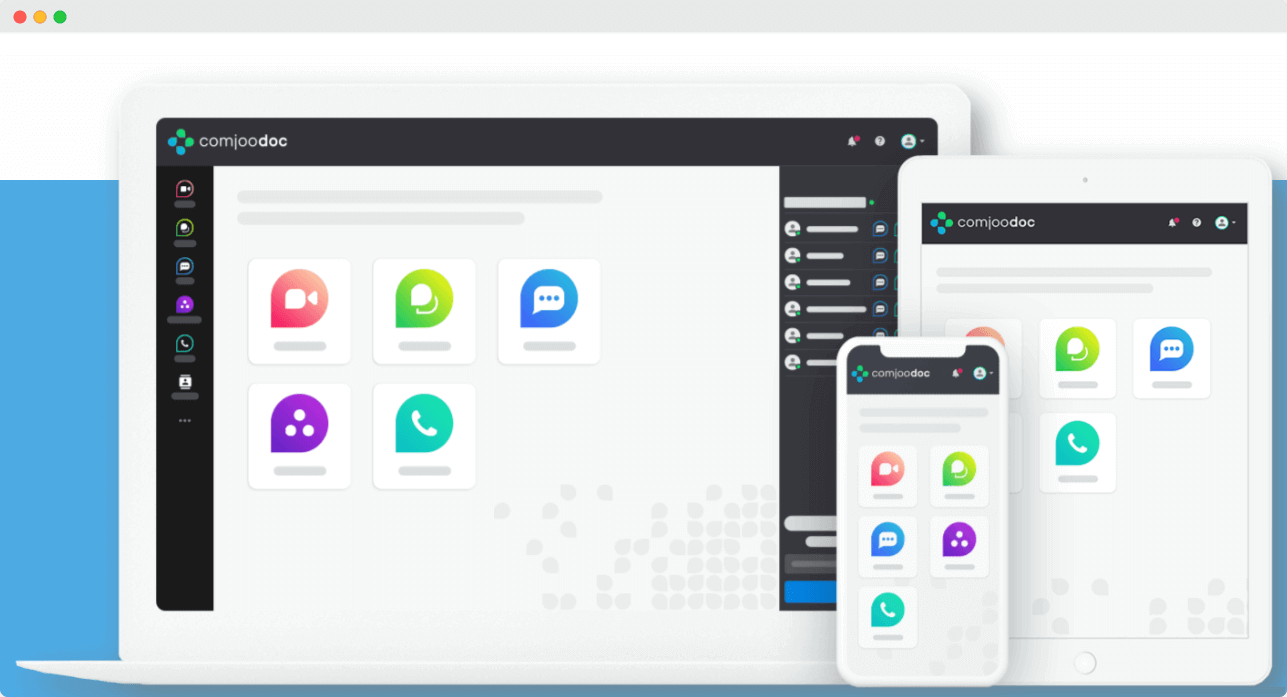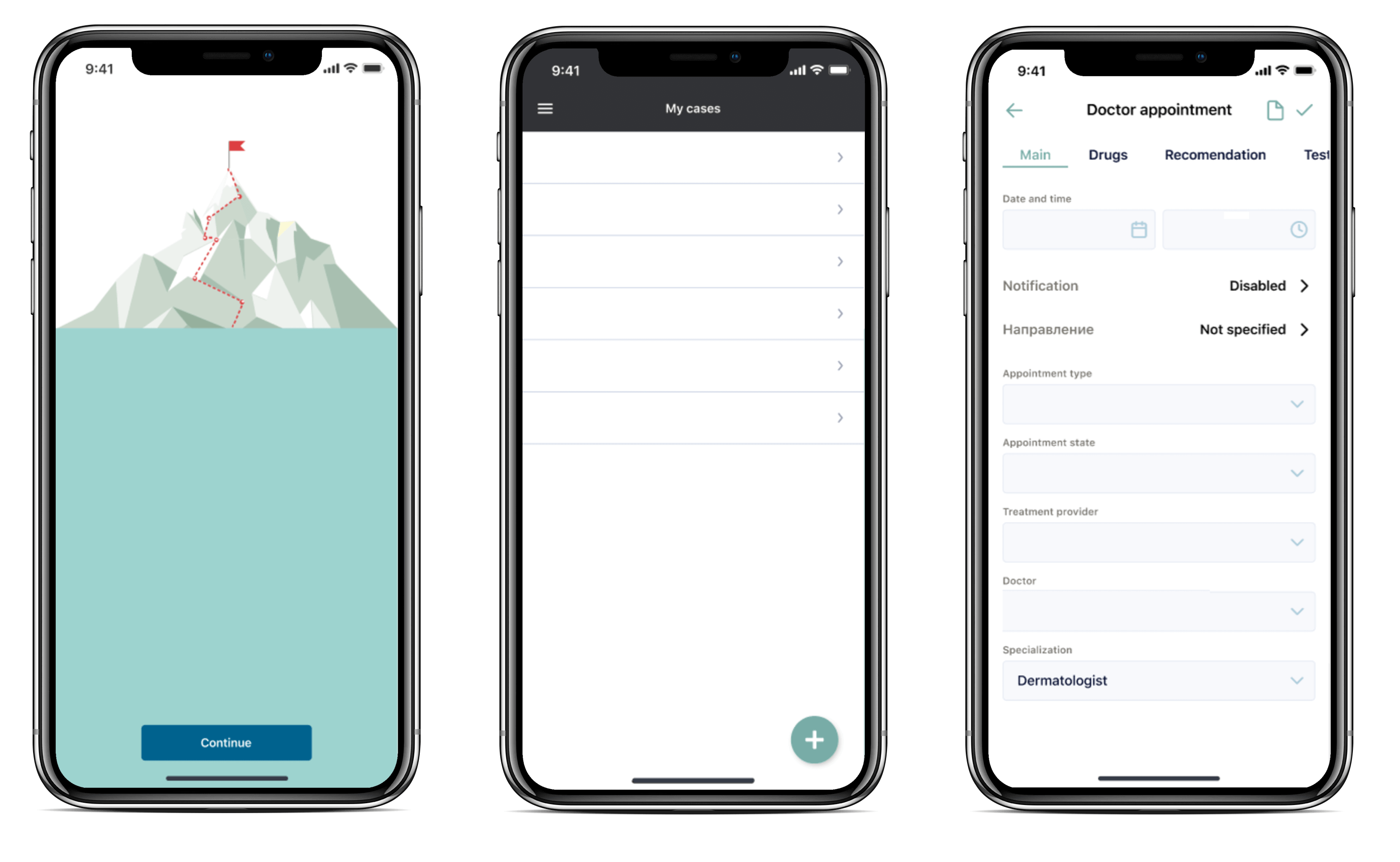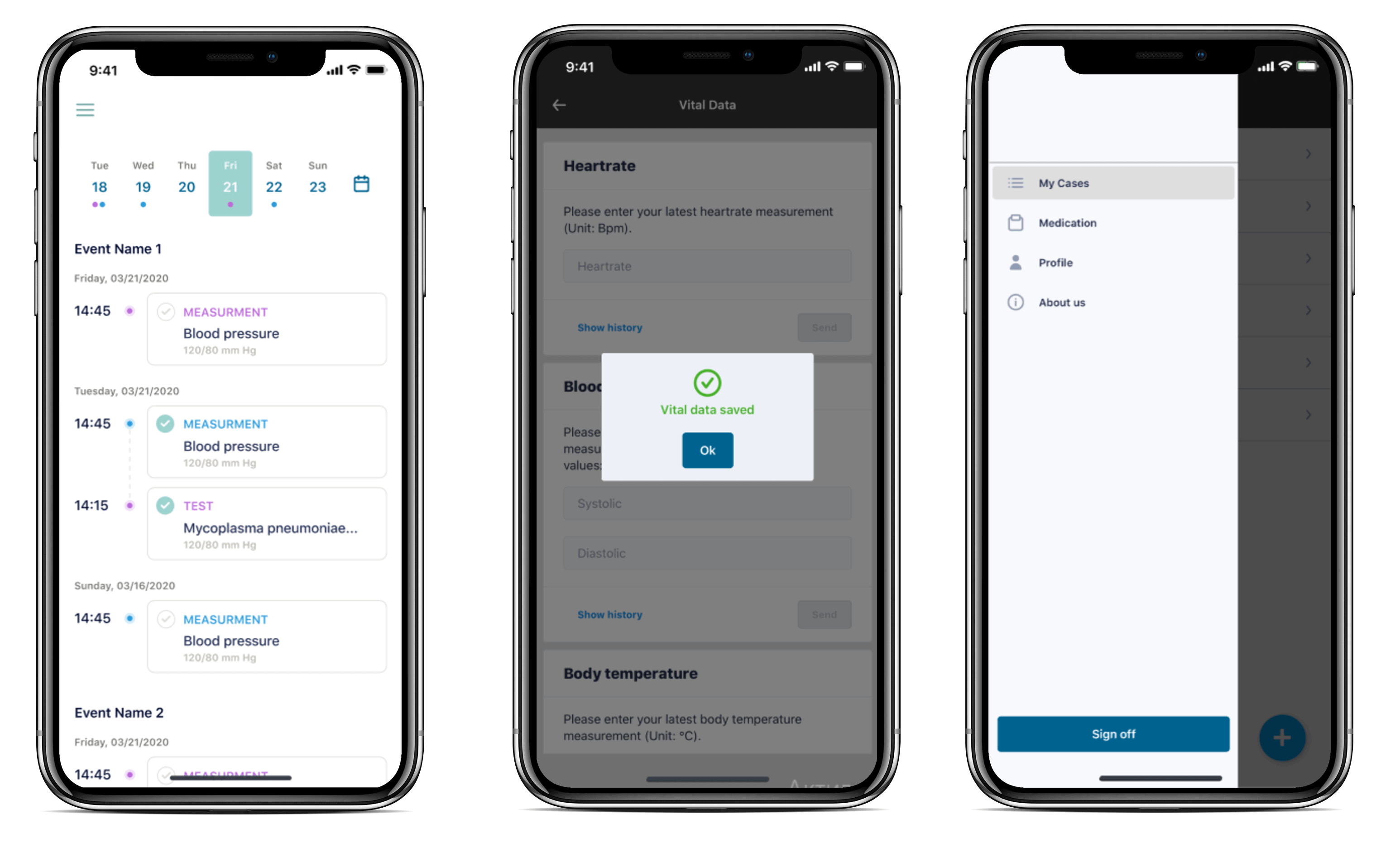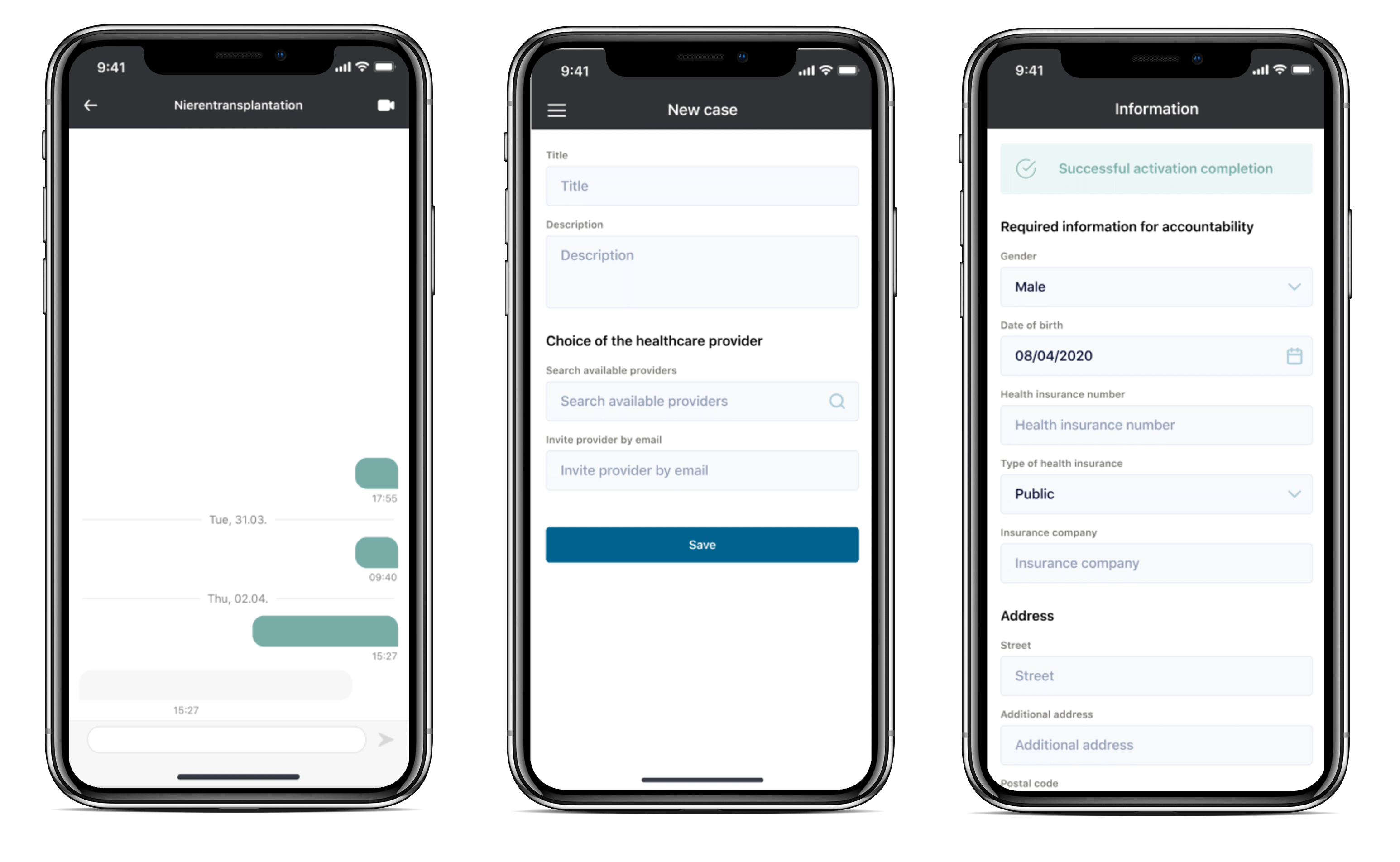A white-label telemedicine platform
About the project
About the project
The client is the owner of a medical center in Berlin, Germany. After the COVID-19 outbreak, he faced the need to provide patients with a distance communication solution to decrease the number of offline visits, while enabling doctors to monitor vital patient health data and streamline communication with a laboratory.
For his goals, the client decided to use a comjoodoc telemedicine app, popular in the German region, that includes:
- Two mobile apps: one for patients and one for medical professionals, developed on React Native.
- A web application built on Node JS and Typescript. The web app also leverages Doker as app containerization technology and Kubernetes for automated deployment and management.

Unfortunately, the platform failed to meet the client’s business goals due to a lack of functionality. Thus, the client hired us to turn a comjoodoc telemedicine platform into a white-label solution.
CASE STUDY: REAL-TIME DIAGNOSTICS FROM NANOPORE DNA SEQUENCERS
Client challenges
In creating the telemedicine platform, the client wanted to accomplish three goals:
Challenge 1. Change the UI design
We needed to redesign the screens of both patient and doctor apps of comjoodoc EASY to match the new branding.
Challenge 2. Add more advanced functionality
We needed to enhance the existing comjoodoc EASY feature list by integrating more advanced features to a live-chat and main menu so that medical professionals could provide effective distant treatment to patients during the COVID-19 pandemic.
Challenge 3. Make the platform compliant with legal regulations
Since the platform handles and stores sensitive patient data, we needed to make it compliant with the legal regulations for patient data security, including:
- German national regulations
- BSI IT grundschtung
- EU-DSGVO/GDPR
- EU healthcare regulations
- HIPAA regulations
CASE STUDY: AN MHEALTH MOBILE APP
Our solution
To meet the client’s goal, we accomplished the following tasks:
Whitelabel setup
We slightly redesigned the interface of patient and doctor apps by:
- Updating the app’s theme, icons, and splash screen
- Designing the new layout for both interfaces
- Adding the client’s information to the Terms and Conditions section
- Creating new onboarding screens for mobile applications
Apart from changes in the user interface, we also made some improvements to the backend:
- Configuring Google services for app’s analytics
- Changing the bundles of databases
- Doing architecture review to meet the business’ needs
- Performing code refactoring by restructuring the existing platform’s code without changing its external behavior to make the code more efficient and maintainable
TELEMEDICINE VS. TELEHEALTH: A COMPREHENSIVE GUIDE ON THE DIFFERENCES & BENEFITS
Functionality integration in response to COVID-19
We improved the functionality of both patient and doctor mobile applications by:
- Integrating Push Notification center via the Firebase development platform
- Increasing the chat capabilities with uploading and sending pictures and files
- Integrating medication prescriptions and laboratory test results, sent as structured data from doctors to the laboratory

- Adding patient management feature to the doctor’s app, so medical specialists could monitor patient status based on one’s reported state of health
- Adding on-premise video conferencing as a custom integration of the ITC cloud video service

- Enabling the calendar functionality for scheduling appointments with doctors, medicine, exercise reminders, and daily schedule for patients
- Enabling online payments with PayPal payment gateway

CASE STUDY: ORB HEALTH – СARE MANAGEMENT AS A VIRTUAL SERVICE
Data security to meet legal regulations
Both the platform and apps are rated as medical devices CE class IIa that store and handle sensitive healthcare information.
We protected data from unauthorized access of third parties by:
- Using SSL data encryption for exchanging data from applications to server
- Adding an encrypted communication layer (SSL) to the client’s storage
- Adding end-to-end encryption to online chat and video conferencing
- Organizing data transmission in FHIR HL7 standard for health care data exchange using FHIR HL7 infrastructure
PODCAST #2. DISRUPTING HEALTHCARE SERVICES
Project tech stack
- Node.js
- Python
- PHP
- React Native
- Kubernetes
- Dockers
- Firebase
- ITC video conferencing software
Team composition
- Solution Architect
- Full Stack developer
- React Native developer
- Designer
- PM
- QA
CASE STUDY: BUENOPR – 360° APPROACH TO HEALTH
Results
After working with us, the client received a white-label telemedicine platform with advanced features that took us two months.
The while-label platform brings benefits to both types of users:
Medical professionals can exchange files with patients via secured live chat, send, and receive laboratory tests in a more streamlined way.
Patients can receive high-quality medical services in the comfort of their homes, schedule appointments with doctors, attend medical meetings online, get receipts for medication, and medical treatment plans with a daily schedule. The app also allows patients to pay for medical services online.
For his goals, the client decided to use a comjoodoc telemedicine app, popular in the German region, that includes:
- Two mobile apps: one for patients and one for medical professionals, developed on React Native.
- A web application built on Node JS and Typescript. The web app also leverages Doker as app containerization technology and Kubernetes for automated deployment and management.

Unfortunately, the platform failed to meet the client’s business goals due to a lack of functionality. Thus, the client hired us to turn a comjoodoc telemedicine platform into a white-label solution.
CASE STUDY: REAL-TIME DIAGNOSTICS FROM NANOPORE DNA SEQUENCERS
Client challenges
In creating the telemedicine platform, the client wanted to accomplish three goals:
Challenge 1. Change the UI design
We needed to redesign the screens of both patient and doctor apps of comjoodoc EASY to match the new branding.
Challenge 2. Add more advanced functionality
We needed to enhance the existing comjoodoc EASY feature list by integrating more advanced features to a live-chat and main menu so that medical professionals could provide effective distant treatment to patients during the COVID-19 pandemic.
Challenge 3. Make the platform compliant with legal regulations
Since the platform handles and stores sensitive patient data, we needed to make it compliant with the legal regulations for patient data security, including:
- German national regulations
- BSI IT grundschtung
- EU-DSGVO/GDPR
- EU healthcare regulations
- HIPAA regulations
CASE STUDY: AN MHEALTH MOBILE APP
Our solution
To meet the client’s goal, we accomplished the following tasks:
Whitelabel setup
We slightly redesigned the interface of patient and doctor apps by:
- Updating the app’s theme, icons, and splash screen
- Designing the new layout for both interfaces
- Adding the client’s information to the Terms and Conditions section
- Creating new onboarding screens for mobile applications
Apart from changes in the user interface, we also made some improvements to the backend:
- Configuring Google services for app’s analytics
- Changing the bundles of databases
- Doing architecture review to meet the business’ needs
- Performing code refactoring by restructuring the existing platform’s code without changing its external behavior to make the code more efficient and maintainable
TELEMEDICINE VS. TELEHEALTH: A COMPREHENSIVE GUIDE ON THE DIFFERENCES & BENEFITS
Functionality integration in response to COVID-19
We improved the functionality of both patient and doctor mobile applications by:
- Integrating Push Notification center via the Firebase development platform
- Increasing the chat capabilities with uploading and sending pictures and files
- Integrating medication prescriptions and laboratory test results, sent as structured data from doctors to the laboratory

- Adding patient management feature to the doctor’s app, so medical specialists could monitor patient status based on one’s reported state of health
- Adding on-premise video conferencing as a custom integration of the ITC cloud video service

- Enabling the calendar functionality for scheduling appointments with doctors, medicine, exercise reminders, and daily schedule for patients
- Enabling online payments with PayPal payment gateway

CASE STUDY: ORB HEALTH – СARE MANAGEMENT AS A VIRTUAL SERVICE
Data security to meet legal regulations
Both the platform and apps are rated as medical devices CE class IIa that store and handle sensitive healthcare information.
We protected data from unauthorized access of third parties by:
- Using SSL data encryption for exchanging data from applications to server
- Adding an encrypted communication layer (SSL) to the client’s storage
- Adding end-to-end encryption to online chat and video conferencing
- Organizing data transmission in FHIR HL7 standard for health care data exchange using FHIR HL7 infrastructure
PODCAST #2. DISRUPTING HEALTHCARE SERVICES
Project tech stack
- Node.js
- Python
- PHP
- React Native
- Kubernetes
- Dockers
- Firebase
- ITC video conferencing software
Team composition
- Solution Architect
- Full Stack developer
- React Native developer
- Designer
- PM
- QA
CASE STUDY: BUENOPR – 360° APPROACH TO HEALTH
Results
After working with us, the client received a white-label telemedicine platform with advanced features that took us two months.
The while-label platform brings benefits to both types of users:
Medical professionals can exchange files with patients via secured live chat, send, and receive laboratory tests in a more streamlined way.
Patients can receive high-quality medical services in the comfort of their homes, schedule appointments with doctors, attend medical meetings online, get receipts for medication, and medical treatment plans with a daily schedule. The app also allows patients to pay for medical services online.